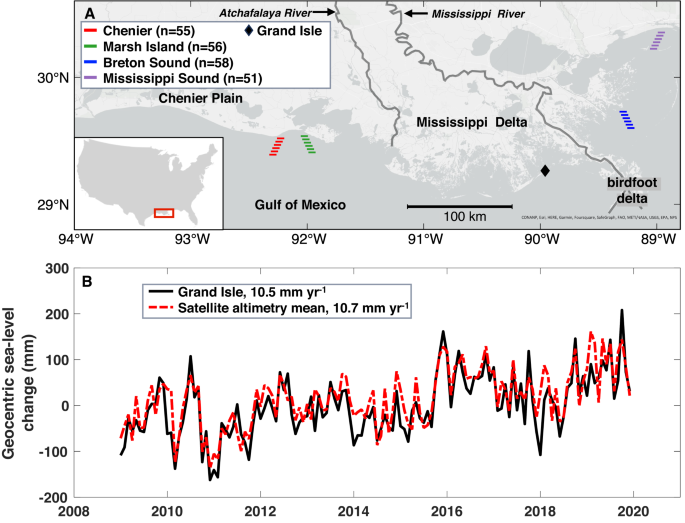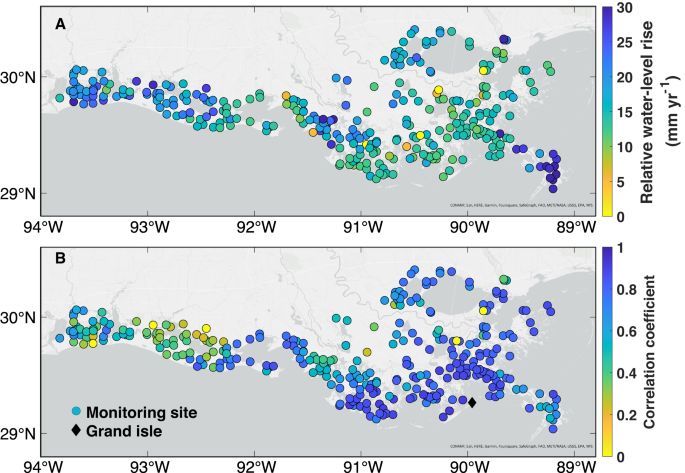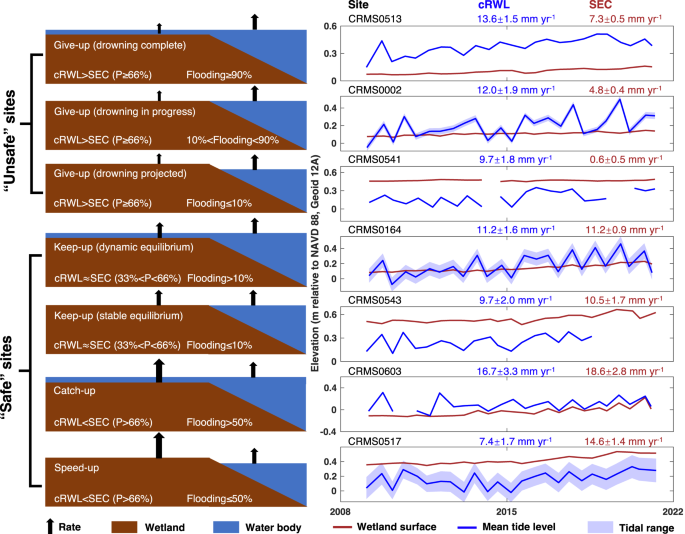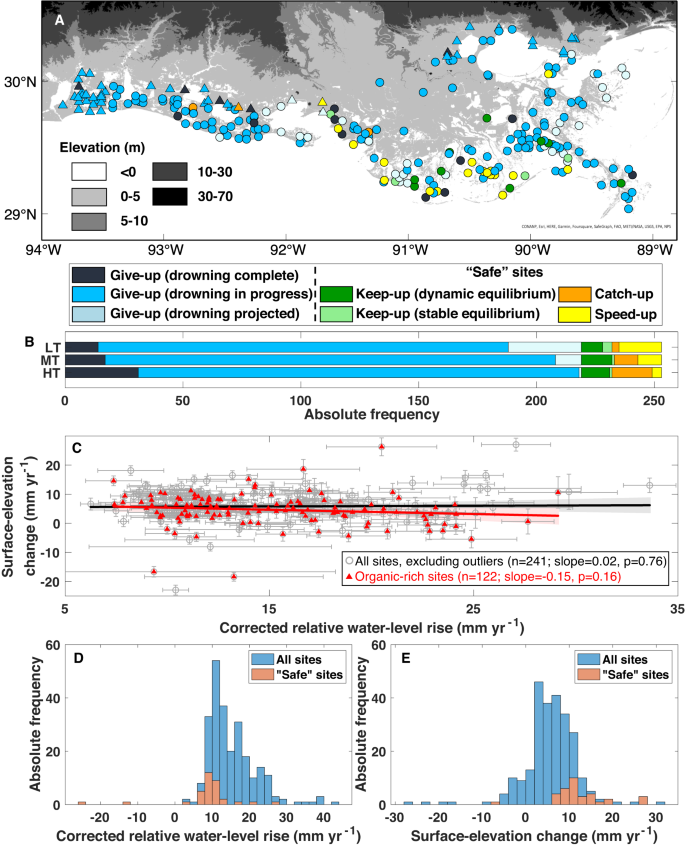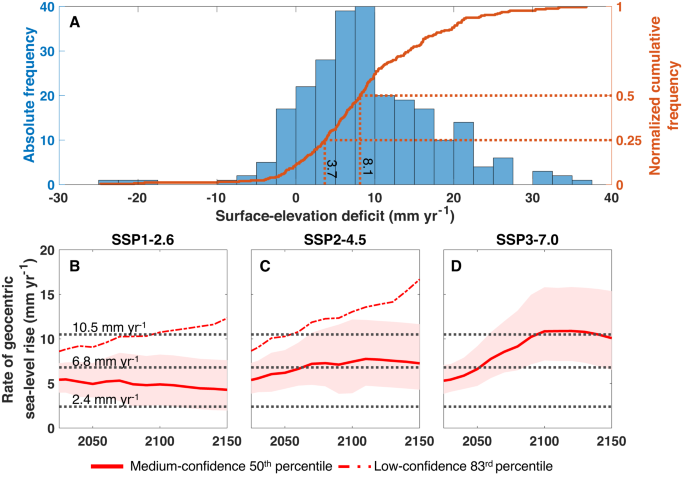Propagation of sea-level rise into coastal wetlands
The rapid acceleration of GSL rise along the Gulf Coast commenced in 201021, with a rate at the Grand Isle tide gauge between 2009 and 2019 of 10.8 mm yr−1 (Fig. 1B). To validate this rate, we examine the coastal GSL change from reprocessed satellite altimetry data26 covering the period January 2009–December 2019 (see “Methods”). Four satellite altimetry virtual stations near the Louisiana coast provide monthly GSL change at points as close as 2 km from the shoreline to 20 km offshore, and more than 50 points are included within each of these 20 km coastal bands (Fig. 1A and Supplementary Fig. 1).
The GSL changes at the Grand Isle tide gauge and mean GSL changes from all four virtual stations (Fig. 1B) are highly correlated (r = 0.8, p < 0.001). Comparison of GSL change at Grand Isle and individual point measurements within the four virtual stations suggest lower correlation coefficients and higher standard deviations near the shoreline than farther offshore (Supplementary Fig. 2), likely due to complex coastal geomorphology, shallow water depth, and land contamination of the satellite altimetry signal. Rates of GSL change for each individual point (n = 220) (Supplementary Fig. 1) fluctuate around 10 mm yr−1, with a mean rate of 10.7 mm yr−1 (Fig. 1B), closely mimicking the 10.8 mm yr−1 GSL rise at the Grand Isle tide gauge (see Methods).
We next assess relative water-level (RWL) change within the Louisiana coastal wetlands by analyzing data from water-level gauges at 325 monitoring sites from 2009 to 2021 (see “Methods”). The median rate of RWL change is 15.7 mm yr−1 (mean: 16.7 ± 7.0 mm yr−1) with more than 97% of these sites showing statistically significant RWL rise (p < 0.001; Fig. 2A). During the same period, the GSL rise at the Grand Isle tide gauge is 10.5 mm yr-1. This difference is because the water-level gauges also capture a significant portion of subsidence. For example, the high rates of RWL rise in the birdfoot delta (~30 mm yr−1) are very likely due to compaction within the ~100-m-thick Holocene sediment column in this area27 (Fig. 2A). Rapid RWL rise is also found in an impounded portion of the Chenier Plain which is heavily impacted by manmade water control structures28. This is the area where monitoring sites exhibit lower correlation coefficients between RWL change and GSL change at the Grand Isle tide gauge (Fig. 2B). In the Mississippi Delta, a higher correlation is observed closest to the coast, suggesting a decreasing ocean influence farther inland. At the birdfoot delta, slightly lowered correlation coefficients may be related to elevated water levels during prolonged floods29 (Fig. 2B). In summary, RWL changes across the Louisiana coast show that 97.2% of sites exhibit a statistically significant correlation (p < 0.001) with GSL change at the Grand Isle tide gauge, with a median correlation coefficient of 0.74 (Fig. 2B). Hence, GSL rise is the main factor driving RWL rise in coastal Louisiana, except in the highly impounded Chenier Plain28 and near river mouths.
A Annual RWL trend from 2009 to 2021 (four sites with negative trends are plotted in bright yellow and nine sites with rates >30 mm yr–1 are plotted in dark blue to avoid distortion of the scale). B Correlation coefficient between detrended RWL change at each monitoring site (n = 325) and detrended GSL change from the Grand Isle tide gauge between 2009 and 2021.
Wetland response to accelerated sea-level rise
Commonly, surface-elevation change (SEC) as measured by means of the rod surface-elevation table (RSET) is compared to the relative sea-level (RSL, i.e., GSL plus vertical land motion) trend from the nearest tide gauge to evaluate wetland vulnerability9,23,24,30,31,32. Rather than relying on a limited number of tide gauges, here we use the RWL record from the water-level gauge associated with each monitoring site (n = 253), on average located only 93 m from the associated RSET (Supplementary Fig. 3). Our SEC time series average 12 years in length, i.e., well over the five years previously found to be the minimum to obtain robust SEC data20. In addition, we correct the RWL data by removing the vertical land motion that occurs between the base of the water-level gauge and the RSET (see “Methods”). Then, we compare the rates of wetland SEC and cRWL (corrected relative water-level) change, along with the elevation difference between the wetland surface and the adjacent water surface at each monitoring site, and we consider uncertainties through Monte Carlo simulation (see “Methods”). We then identify different wetland responses by adopting terminology developed to examine coral-reef response to sea-level change33,34. We classify each monitoring site into “give-up,” “keep-up,” or “catch-up,” (including a few subdivisions) and add a “speed-up” category (Fig. 3).
P represents the probability of the specified cRWL-SEC relationship. Characteristic examples from individual monitoring sites are shown on the right with the rate (and one standard deviation) of cRWL change and SEC (see Methods for further details). The location of the example monitoring sites are shown in Supplementary Fig. 6.
With this classification scheme, the full spectrum of possible wetland responses to cRWL change is captured (Fig. 3). The give-up categories reveal that the wetland is unable to keep pace with cRWL rise (i.e., there is a surface-elevation deficit), with the elevation comparison between the wetland and water surface determining whether drowning currently occurs. On the other hand, the keep-up categories suggest that the wetland keeps pace with the cRWL rise, at least for the time interval under consideration. The catch-up category demonstrates that the wetland is gaining elevation despite frequent flooding, and the speed-up category indicates that the wetland is gaining elevation under subaerial conditions. Because tides play an important role in examining wetland flooding, we compare the monthly low tide level, mean tide level, and high tide level with the elevation of the wetland surface in the month when SEC data are collected. The wetland response under the monthly low tide level represents the most conservative assessment illustrated in Fig. 4A (the mean and high tide level outcomes are shown in Supplementary Fig. 5).
A Wetland response for low tide conditions at 253 monitoring sites (mean tide and high tide conditions are shown in Supplementary Fig. 5). Triangles indicate sites where the Pleistocene basement is <2 m deep (n = 51). B Comparison of wetland response under low tide (LT), mean tide (MT), and high tide (HT) conditions. C Correlation between the rate of cRWL rise and surface-elevation change (SEC). Note that data points with rates of cRWL rise lower than the 2.5th percentile or greater than the 97.5th percentile have been excluded. The smaller subset consists of sites with an organic-matter content >30% (see “Methods”). Error bars represent the standard deviation. D Rate of cRWL change for all 253 monitoring sites, with 34 “safe” sites highlighted separately. E As in (D), but for the rate of SEC.
We find that 87% of the monitoring sites fall in the give-up categories, 5% in the keep-up categories, and the remaining 8% in the catch-up or speed-up categories (Fig. 4B). Thus, only 13% represents what we refer to here as “safe” sites (Fig. 3). Give-up sites are widely distributed across coastal Louisiana with the most vulnerable ones (drowning complete or in progress) clustering in the Chenier Plain and inland portions of the Mississippi Delta (Fig. 4A and Supplementary Fig. 5). In contrast, most of the “safe” sites can be found relatively close to the shoreline in the Mississippi Delta.
Factors influencing coastal wetland resilience
The impact of sea-level rise on coastal wetlands is complex and varies depending on local conditions and human activities35. Model studies have suggested that coastal marshes can keep up with rates of RSL rise >12 mm yr−1 23 or even several times higher under favorable environmental conditions8. This has led to the perception that the vulnerability of marshes may have been overestimated24. In contrast, global analyses based on the paleorecord and contemporary in situ surveys have indicated that coastal wetlands are very unlikely to survive when the RSL rise rate exceeds 7 mm yr–1 12, i.e., considerably lower than the GSL rise rate along the Louisiana coast over the past decade.
Our analysis focuses entirely on the ability of coastal wetlands to adjust vertically to RSL rise. It is well established36 that these ecosystems can also retreat landward, and some studies have argued that this could result in net areal growth even under pessimistic climate scenarios37. However, this neglects the fact that under such scenarios wetlands still must cope with the vertical dimension of rapid RSL rise. In addition, although salt marshes can sometimes migrate landward at the expense of freshwater wetlands, freshwater wetlands often cannot migrate into uplands due to the presence of topographic barriers38. Hence, landward migration of coastal wetlands cannot compensate for seaward losses. Coupled modeling of marsh-edge erosion and upland marsh retreat39 demonstrates how their interplay dictates wetland extent as a function of RSL rise, sediment availability, and the upland slope. While this model study suggested that wetlands can expand under a variety of boundary conditions, a major tipping point was identified when rates of RSL rise exceed a threshold (8–9 mm yr-1 in39, although these numbers do not necessarily apply directly to coastal Louisiana). Under such conditions, widespread inundation is predicted with a rapid reduction in wetland extent, similar to what has been observed for the early Holocene in the Mississippi Delta40. We note that wetland sites in our study area which would constitute the nucleus for landward retreat (i.e., those farthest landward that abut gently sloping uplands; triangles in Fig. 4A and Supplementary Fig. 5) dominantly (96%) fall in the give-up category. This is consistent with the model results39 predicting that marsh interiors are particularly vulnerable, with higher resilience near the open coast (as seen in Fig. 4A), corresponding to the inundation scenario where drowning commences in the marsh interior until the seaward edge ultimately jumps landward. This results in a fringing marsh with a much reduced footprint41.
Climate change and elevated CO2 levels may enhance vertical accretion in coastal wetlands by biological feedbacks, another potential mechanism through which wetlands might counterbalance rising sea levels in the future23,24,42. An experimental study conducted in Chesapeake Bay, USA, demonstrated how increased CO2 can stimulate vertical accretion but showed a decline in productivity once the rate of RSL rise surpasses 7 mm yr−1 43. We compare the rates of cRWL change and SEC at all monitoring sites (excluding a small number of outliers; n = 12) in addition to a subset of sites (n = 122) with high organic-matter content, where biological feedbacks are more likely to dominate vertical accretion. Our data show no correlation for either case (Fig. 4C). In other words, we see no evidence for the ecogeomorphic feedbacks proposed by previous studies23,24,42, consistent with observations over the past three decades from the Everglades, Florida44. Despite the high median rate of cRWL rise in coastal Louisiana, 13% of our sites are not yet in give-up mode. These “safe” sites experience a median cRWL rise of 9.7 mm yr−1, i.e., much lower than the overall median (Fig. 4D). This subset of resilient wetland sites also features SEC rates that are roughly twice as high as the median for the entire data set (11.1 vs. 6.0 mm yr−1; Fig. 4E). Given our finding that sites with lower rates of cRWL rise tend to see higher SEC rates, we postulate that the rates of cRWL rise in our study area are well above those where biological productivity benefits from increased flooding. Therefore, we suggest that future studies to understand ecogeomorphic feedbacks be conducted in areas with lower rates of RSL rise, a larger tidal amplitude, and/or semidiurnal or mixed tidal regimes.
Vulnerability of coastal wetlands under future sea-level projections
The median surface-elevation deficit for all monitoring sites during the study period is 8.1 mm yr−1 (Fig. 5A), suggesting that even with a considerably lower rate than the observed GSL rise, widespread wetland collapse is likely to occur. Subtracting the median surface-elevation deficit from the observed rate of GSL rise yields 2.4 mm yr−1, a condition where about half of the monitoring sites would be able to track GSL rise. This is consistent with earlier inferences20 that adopted a GSL rise rate of only 2 mm yr−1 and found about half of the monitoring sites to be in deficit. We also examine the outcome for the 25th percentile (Fig. 5A) which corresponds to a surface-elevation deficit of 3.7 mm yr–1. A similar subtraction yields a value of 6.8 mm yr–1, suggesting that under such a rate of GSL rise about 75% of sites would be in deficit.
A Distribution of surface-elevation deficits for all sites (n = 253) and the cumulative distribution curve (negative values indicate a surface-elevation surplus), with values highlighted for the 25th and 50th percentiles. Projected GSL rise rates (with 1σ confidence interval shaded) for SSP1-2.6 (B), SSP2-4.5 (C), and SSP3-7.0 (D). The three dashed lines (black) in (B–D) indicate the observed rate of GSL rise (2009–2021), along with rates after subtracting values corresponding to the 25th and 50th percentiles of surface-elevation deficits, respectively.
According to the Sixth Assessment Report of the Intergovernmental Panel on Climate Change (IPCC-AR6)45, with policies currently in place, we are approximately following Shared Socioeconomic Pathway (SSP) 2–4.5. Projections of GSL rise along the Louisiana coast indicate that even under SSP1-2.6 (which would require Paris Agreement objectives to be achieved), the rate of GSL rise is very likely to exceed 2.5 mm yr–1, putting at least half of the sites in danger of drowning (Fig. 5B). Under SSP2-4.5, GSL rates are projected to surpass 7 mm yr–1 by 2070 (Fig. 5C). As a result, it is plausible that ~75% of the wetlands will lack the resilience necessary to withstand rising sea level by 2070 under the present climate scenario. Under SSP3-7.0, it is more likely than not that the rate of GSL rise observed over the past decade will be reached by the end of this century, with ~90% of wetlands drowning as a result (Fig. 5D). It is worth noting that these GSL projections are based on medium-confidence processes; without consideration of low-confidence processes (high magnitude/low probability non-linear ice-sheet responses7). Recent studies have reported increasing contributions to GSL rise from both Greenland and Antarctica46,47,48, indicating that high-impact, low-confidence processes cannot be ruled out. The corresponding low-confidence GSL rise projections for SSP1-2.6 and SSP2-4.5 (83rd percentile) exhibit higher rates and magnitudes than the median projections for SSP3-7.0. As a result, ~90% drowning of wetlands may occur as early as 2090 and 2060, respectively under these scenarios (Fig. 5B, C).
As mentioned before, our focus herein is on the vertical adjustment of coastal wetlands with an emphasis on low-tide conditions (Fig. 4A). It is also important to note that the RSETs were deliberately established in relatively intact wetlands to enable long-term monitoring, i.e., land loss due to marsh-edge erosion is generally not captured by our analysis. Furthermore, it is reasonable to expect that multi-decadal cycles due to ocean dynamic changes will continue to be superimposed on the climate-driven global sea-level rise21, i.e., periods with rates of GSL rise higher than in the past decade may well occur before 2070. Combined, all these factors suggest that our analysis may underestimate wetland vulnerability. The aforementioned threshold rate of 7 mm yr–1 12 corresponds to a condition where about 75% of our monitoring sites are in deficit. Although we are reluctant to convert this number into precise rates of wetland loss, within a time window of <50 years this would translate into loss rates well above anything that has been observed in the past century.
The unusual exposure of the Louisiana coast to accelerated sea-level rise over the past decade provides a unique opportunity to time travel to conditions not expected until later in this century. As such, this study offers empirical evidence of the transformation of a heavily human-influenced landscape due to climate change by means of a globally unprecedented monitoring system. This climate-impact experiment shows that widespread collapse of coastal wetlands in this area may be expected by 2070 or earlier. While this outcome may not be entirely avoidable, climate mitigation along with major restoration efforts by means of sediment diversions49 could delay wetland drowning and allow for more time to prepare for this large-scale coastal transformation.

